As dog’s age, they may experience a decline in muscle mass and strength, which can make it difficult for them to maintain their mobility. Strengthening an old dog’s hind legs can help improve its overall mobility and quality of life. This page will be exclusive on how to strengthen old dogs hind legs.
Some simple and effective ways to do this include stretching, massaging, swimming, and walking slowly. Maintaining a healthy weight can help reduce the strain on the hind legs and improve overall mobility.
Moreover, giving them supplements, such as glucosamine and chondroitin, may help support joint health and improve mobility in older dogs. It’s always a good idea to consult a veterinarian before starting any new exercise routine, especially for older dogs or those with underlying health conditions. With patience and dedication, these exercises can help improve your dog’s strength and mobility in its hind legs.
How to strengthen old dogs hind legs
To strengthen an old dog’s hind legs, you can incorporate low-impact exercises into their daily routine. Some options may include the following:
Gentle stretches
Help your dog stretch their hind legs by gently lifting and holding each leg for a few seconds.
Gentle massage
Massaging your dog’s hind legs can help increase blood flow and improve flexibility.
Swimming
Swimming is a great low-impact exercise that can help strengthen your dog’s hind legs.
Slow walks
Going for slow walks on a flat surface can help your dog get some exercise while minimizing the impact on its hind legs.
It’s essential to consult with your veterinarian before starting any new exercise routine for your dog, especially if they have any underlying health conditions or are older.
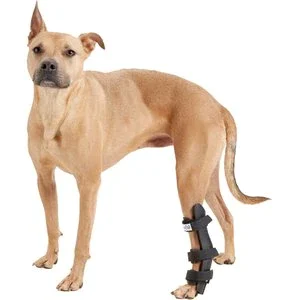
10 Tips on how to strengthen old dog’s hind legs
Here are 10 tips for strengthening your old dog’s hind legs:
1. Consult with a veterinarian: It is crucial to evaluate your dog to determine the cause of its hind leg weakness and the best course of treatment. The veterinarian may recommend specific exercises or other interventions to help strengthen the hind legs.
2. Gradually increase exercise: Gradually increase the amount and intensity of your dog’s exercise to help build strength in their hind legs. This could include walks, runs, or playtime in the backyard.
3. Use assistive devices: Assistive devices, such as a sling or a hind leg harness, can help support your dog’s hind legs and allow them to move around more easily. This can help them build strength and confidence in their hind legs.
4. Try hydrotherapy: Water therapy, such as swimming or exercising in a pool, can be a great way to help strengthen your dog’s hind legs. The buoyancy of the water helps support their weight, making it easier for them to move and exercise.
5. Use stairs and inclines: Stairs and slopes can help challenge your dog’s hind legs and build strength. Start slowly and gradually increase the difficulty as your dog becomes more comfortable and robust.
6. Practice standing and balancing exercises: Exercises that involve standing on one leg or balancing on an unstable surface can help improve muscle strength and coordination in your dog’s hind legs.
7. Use weight-bearing exercises: Exercises that involve your dog bearing weight on their hind legs, such as squats or lunges, can help build strength and improve muscle tone.
8. Try massage: Massaging your dog’s hind legs can help improve circulation and muscle tone.
9. Give a balanced diet: A balanced diet with the right amount of protein, fat, and other nutrients can help support muscle health and strength.
10. Keep your dog active: Regular activity.
Why do old dogs lose strength in their back legs?
There are several reasons why older dogs may lose strength in their back legs. These include age-related muscle atrophy, degenerative joint conditions such as osteoarthritis, neurological disorders like degenerative myelopathy, and spinal cord injuries or disk herniations.
In many cases, the loss of strength in the hind legs is due to a combination of factors, and the specific cause can be challenging to determine. Age-related muscle atrophy is a common factor in the loss of strength in older dogs, as the muscles naturally begin to weaken and shrink with age.
Degenerative joint conditions and neurological disorders can also contribute to muscle weakness, as they can cause pain and difficulty with movement.
If your dog is experiencing weakness in its hind legs, and it is essential to have them evaluated by a veterinarian to determine the cause and the best course of treatment.
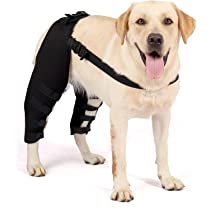
How can I build my dogs back leg muscles?
There are several ways to help build your dog’s back leg muscles:
Increase exercise
Increasing your dog’s overall physical activity can help build muscle strength in its hind legs. You can achieve this through walking, running, swimming, and playing fetch.
Use stairs
Stairs can be an excellent tool for building leg muscle strength in dogs. Start by having your dog walk up and down a few stairs at a time and gradually increase the number of stairs as they become more comfortable.
Use a treadmill
A treadmill can be an excellent way to increase your dog’s leg muscle strength, allowing them to walk or run at a controlled speed.
Resistance training
Resistance training, such as using a weight vest or doing exercises like “sit to stands” or “leg presses,” can help build muscle strength in your dog’s hind legs.
Please consult your veterinarian before starting any new exercise program for your dog to ensure that it is safe and appropriate for its specific needs and health status.
How Long Can dogs live with weak back legs?
A dog can endure weak back legs for about 8 to 10 months. Some dogs may live an average lifespan with proper management of their condition. In contrast, others may have a shorter lifespan depending on the underlying cause and the impact on their overall health.
However, the lifespan of a dog with weak back legs will depend on the underlying cause of the weakness, the severity of the condition, and the effectiveness of any treatment or management strategies.
Many dogs may be able to live an expected lifespan with proper care and management. In contrast, others may have a shorter lifespan depending on the condition’s impact on their overall health and well-being.
If your dog is experiencing weakness in its hind legs, it is vital to have them evaluated by a veterinarian to determine the cause and the best course of treatment.
How do you rehab a dog’s back leg?
Rehabilitating a dog’s back leg typically involves a combination of rest, physical therapy, and medication. The specific treatment plan will depend on the cause of the injury or condition affecting the leg and the severity of the issue. Some general steps that may include in a rehabilitation plan for a dog’s back leg include:
1. Rest: It is essential to allow the leg to rest and heal. This may involve keeping the dog confined to a small area or using a crate or crate-like enclosure to prevent the dog from moving around too much.
2. Physical therapy: Physical therapy can help to improve muscle strength, flexibility, and range of motion in the leg. This may involve exercises such as stretching, massage, and controlled movements.
3. Medication: Depending on the cause of the injury or condition, your veterinarian may prescribe medication to help reduce inflammation and manage pain.
4. Other treatments: Depending on the specifics of the injury or condition, you may recommend other therapies. These may include assistive devices such as a sling or cart, hydrotherapy (exercise in water), or acupuncture.
However, follow your veterinarian’s instructions and any recommendations for rehabilitating your dog’s back leg. Being patient and allowing the leg time to heal is also essential. Rehabilitation can be a slow process, but with proper care and treatment, it is often possible to improve your dog’s mobility and quality of life.
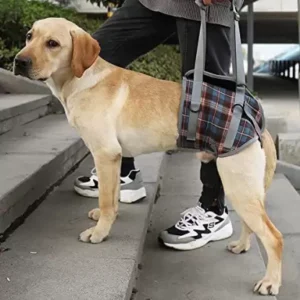
What is the dog hind leg weakness treatment?
The treatment for the dog’s hind leg weakness will depend on the underlying cause of the weakness. Some standard treatment options may include medications to manage pain, inflammation, or other symptoms.
Physical therapy to improve muscle strength and mobility in the affected leg; rehabilitation equipment to help improve muscle strength and mobility; assistive devices to support the affected leg and allow the dog to move around more efficiently; and surgery to repair damage to the leg or address underlying conditions.
It is vital to work with a veterinarian to determine the best treatment plan for your dog’s hind leg weakness. The treatment plan will depend on the underlying cause of the weakness and the severity of the condition.
The goal of treatment is to improve muscle strength, flexibility, and mobility in the affected leg and to manage any pain or discomfort. Your veterinarian can recommend the most appropriate treatment options for your dog based on its specific needs and condition.
What can I use for hind leg support for dogs?
Can use several options to provide hind leg support for dogs, including the following:
1. Wheelchair: A wheelchair is a device that allows a dog to move around while supporting its hind legs. These are typically used for dogs with paralysis or other conditions affecting their walking ability.
2. Hip harness: A hip harness is a device that wraps around a dog’s hips and supports its hind legs. This can be helpful for dogs with hip dysplasia or other conditions that affect their ability to walk.
3. Leg braces: Leg braces are devices worn on a dog’s legs that support its hind limbs. These can be helpful for dogs with arthritis or other conditions that affect their mobility.
4. Sling: A sling is a device that supports a dog’s hind end and allows them to move around while its hind legs are off the ground. This can be helpful for dogs that are recovering from surgery or other injuries.
Consultation with a canine rehabilitation specialist to determine the best option for your dog would be great. They can assess your dog’s condition and recommend the most appropriate hindleg support.
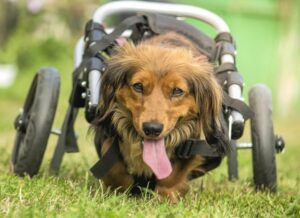
What can I give my dog for weak back legs?
If your dog is experiencing weakness in its back legs, it is essential to have them evaluated by a veterinarian to determine the cause and the best course of treatment. The treatment plan will depend on the underlying cause of the weakness and the severity of the condition.
Some common treatment options for weakness in the hind legs may include medications to manage pain, inflammation, or other symptoms. Physical therapy exercises and techniques can also help improve muscle strength and mobility in the affected leg.
These may include stretches, massages, and exercises to improve the range of motion. Specialized equipment, such as treadmills, balance boards, and water therapy pools, can be used to help improve muscle strength and mobility in the affected leg.
Assistive devices, such as a wheelchair or sling, can also help support the affected leg and allow the dog to move around more easily. Surgery may be necessary to repair damage to the leg or address underlying conditions such as a herniated disk or a torn ligament.
Working with a veterinarian to determine the best treatment plan for your dog’s weak back legs is essential.
Why do dogs hind legs get weak?
Several reasons a dog’s hind legs may become weak or impaired. Some possible causes include the following:
Aging or degenerative joint diseases
As dog’s age, they may develop degenerative joint diseases such as osteoarthritis, which can cause weakness in the hind legs.
Injuries or trauma
Traumatic injuries, such as fractures or sprains, can cause weakness in the hind legs.
Neurological disorders
Neurological disorders, such as spinal cord or brain injuries, can cause weakness or paralysis in the hind legs.
Degenerative myelopathy
Degenerative myelopathy is a progressive neurological disorder that affects the spinal cord and can cause weakness or paralysis in the hind legs.
Hip dysplasia
Hip dysplasia is a genetic condition that causes the hip joint to develop abnormally, leading to pain and weakness in the hind legs.
It is best to consult with a veterinarian if you notice any changes in your dog’s hind leg function, as the cause of the weakness may require medical attention.
Why is old dog back legs collapsing treatment?
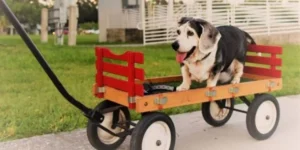
There could be various reasons why a dog’s back legs are collapsing. Some possible causes of a dog’s back legs collapsing include:
Musculoskeletal issues: Dogs can develop arthritis or other degenerative conditions that affect the joints and muscles in their back legs, leading to weakness and difficulty standing or walking. In these cases, treatment may involve pain management and supportive care, such as physical therapy or assistive devices like a cart or sling.
Neurological issues: A collapsing of the back legs can also be a sign of a neurological disorder, such as a spinal cord injury or a degenerative disease like degenerative myelopathy. In these cases, treatment may involve medications to manage symptoms and supportive care to help the dog maintain mobility.
Cardiovascular issues: In some cases, a collapsing of the back legs may be a sign of a cardiovascular issue, such as a heart problem or poor circulation. Treatment for these conditions may involve medications or other interventions to improve the dog’s overall health and strength.
In some cases, treatment may involve a combination of medications, supportive care, and lifestyle changes. It is also essential to follow the treatment plan directed by the veterinarian to maximize the chances of a positive outcome.
Why is my old dog back legs collapsing and vomiting?
There are several potential causes for an old dog’s collapsing hind legs and vomiting. One possibility is degenerative myelopathy, a progressive neurological disorder that affects the spinal cord and can cause weakness or paralysis in the hind legs. Degenerative myelopathy is more common in older dogs and may accompany vomiting and other symptoms.
Another potential cause is a spinal cord injury, which can occur due to trauma or other types of damage and may cause weakness or paralysis in the hind legs, vomiting, and other symptoms.
Disk herniation, when a disk in the spine becomes herniated and presses on the spinal cord or nerve roots, can cause collapsing hind legs and vomiting in dogs.
Osteoarthritis, a degenerative joint condition that causes pain and stiffness, is another possible cause of collapsing hind legs and vomiting in old dogs. Many other medical conditions can also cause these symptoms in dogs, including infections, kidney disease, pancreatitis, and more.
Do dog loses use of back legs temporarily?
The possibility for a dog to temporarily lose the use of its hind legs may be due to a variety of factors.
Some possible causes of temporary hind leg weakness or paralysis in dogs may include trauma, such as fractures, dislocations, or spinal cord injuries. Infections, such as tick-borne diseases or meningitis; spinal cord compression due to herniated disks or other conditions; toxicities, such as poisoning or exposure to toxins; and other medical conditions, such as stroke or pancreatitis.
Suppose your dog is experiencing temporary hind leg weakness or paralysis. In that case, it is essential to have them evaluated by a veterinarian as soon as possible to determine the cause and the best course of treatment. The treatment plan will depend on the underlying cause of the symptoms and the severity of the condition.
In some cases, treatment may involve medications to manage pain or inflammation, physical therapy to improve muscle strength and mobility, and assistive devices to support the affected legs and allow the dog to move around more easily.
Why do my dog dragging one back leg suddenly?
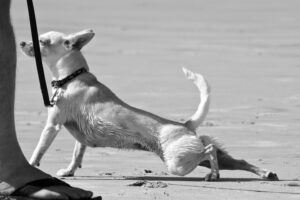
There could be several potential causes for your dog suddenly dragging one of its hind legs. Some possible causes may include injuries, such as a fracture, dislocation, or another type of injury to the leg or spine. Neurological disorders, such as degenerative myelopathy or intervertebral disc disease.
These can cause weakness or paralysis in one hind leg and may be accompanied by other symptoms such as loss of coordination, muscle wasting, and difficulty standing or walking. Spinal cord compression due to herniated disks or other conditions; infections, such as tick-borne diseases or meningitis; and other medical conditions, such as stroke or pancreatitis.
Conclusion
Start with low-impact exercises to strengthen an old dog’s hind legs and gradually increase intensity and duration.
This can include swimming, gentle leash walks, and exercises that involve balancing and standing on their hind legs. It is also essential to consult a veterinarian or a professional trainer before starting any new exercise routine for an older dog, as certain medical conditions or injuries may require a modified approach.
So, the key is to start slowly and gradually build up the muscles in the hind legs while paying attention to your dog’s comfort and limitations.
Conclusively, following these tips on how to strengthen old dogs hind legs, you can help your aging dog build strength and improve mobility in their hind legs.


